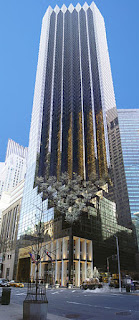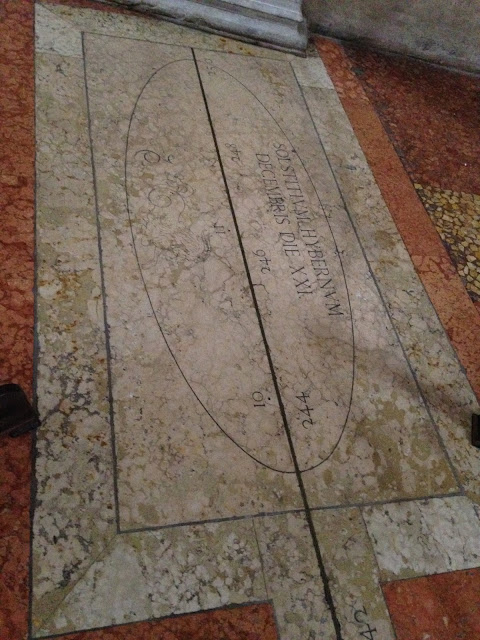Back to St. Petronius: While visiting St. Petronius, we saw a Meridian Line, a sort of sundial installed in the church in 1655 by Italian astronomer and all-around smart person Giovanni Cassini.
So, what is a Meridian Line exactly? It is a north-south line on the ground that follows the curvature of the earth. Check.
To work effectively, the line needs to be inside a very large building. In 1655, Cassini, who worked at the university down the street, concluded that one of the world's largest churches, St. Petronius, would do. Check.
The third element is a small hole in the roof of the building directly above the line where the Sun can shine through. Check.
The final element is the Sun passing overhead everyday. Check.
Once all the elements are in place, you wait and watch. Assuming clouds do not block the sun, an image of the Sun will appear on the floor of the building before noon. As noon approaches, the center of the Sun's image will move across the Meridian Line. At noon, the center of the Sun's image is on the line confirming the time.
Want to see it for yourself? Check out a YouTube video by clicking here.
Pretty cool. But wait, there's more. The Sun's image crosses the line at a different point every day. The Sun's position in the sky changes daily as the year passes. On the Summer solstice, when the Sun is highest in the sky, the Sun's image will cross the end of the line closest to the hole in the roof. On the Winter solstice, the opposite happens. When the Sun is lowest in the sky (and it is really cold outside), the Sun's image will cross the end of the line farthest from the hole in the roof. If you record all the readings from one Summer solstice to the next, you will know the number of days in the solar year. (For more info, click here.)
That Cassini guy was one smart cookie.
We're Movin' On Up: A long time ago, Bologna was a fortified city with guarded walls and gates to keep out people the Bolognese wanted to keep out. In addition, the city was filled with towers, lots and lots of them. One account estimates that, by the mid-13th century, there were 180 towers in Bologna and it might have looked something like this:
Why all the towers? There are two views. One view is practical. While the fortified walls made the wealthier residents of Bolognese feel safe, they did not feel overly safe. During the era when the towers reached skyward, there were two competing rulers seeking world domination. Bologna was stuck in the middle. So, the towers provided a refuge in case a visiting army with undisciplined soldiers arrived in town. In the towers, the occupants could protect their wealth and live securely for a very long time on stockpiled food, water and wine.
The other view is somewhat less practical. Building a tower was a sign of wealth. The larger the tower, the greater the family's wealth. In other words, it was a case of envy, "mine is bigger than yours".
Does this sound familiar? Fast forward 800 years. The skyline of NYC, where huge ego drives more towers higher and higher, looks a lot like the ancient skyline of Bologna. The comparison is more apt when skyscrapers boast a company or family name.
Over time, most of the towers in Bologna were demolished. A few remain, including the two towers pictured below that are located in the center of the city. Hey, is that the leaning tower of Bologna?
The other view is somewhat less practical. Building a tower was a sign of wealth. The larger the tower, the greater the family's wealth. In other words, it was a case of envy, "mine is bigger than yours".
Does this sound familiar? Fast forward 800 years. The skyline of NYC, where huge ego drives more towers higher and higher, looks a lot like the ancient skyline of Bologna. The comparison is more apt when skyscrapers boast a company or family name.
 |
| NYC Skyline |
 |
| The Woolworth Building |
 |
| Some tower in Midtown Manhattan |
 |
| This photo is not crooked. The tower on the left, known as the Garisenda, is leaning 3 meters off center. |
 |
This photo of Garisenda's base confirms how far it is leaning. P.S. That statue is St. Petronius standing guard.
|
While visiting Bologna, Dante saw the tower and wrote it into the end of the Divine Comedy, comparing it to the stooping giant Antaeus.
So, why do people know about the Leaning Tower of Pisa, not the leaning tower of Bologna or the many other leaning towers in Italy? Good marketing is the answer.
Thanks for joining our brief trip to Bologna. Now, it's time to shake off the cold and warm up with some mulled wine. Salute!





No comments:
Post a Comment